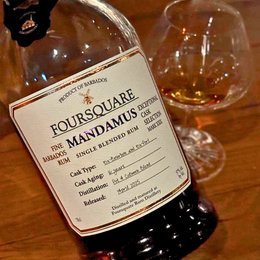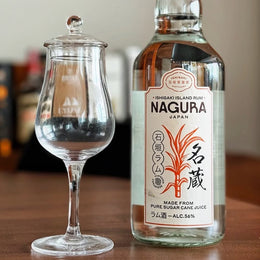
What a throwback!
Yes, yes, this Habitation Velier bottling of Jamaica's Worthy Park was only released in 2016, but in rum years, alot has happened since then (not to mention, alot more rum expressions)!
Worthy Park has been gradually making a name for itself - and yet compared to some of its equally new age neighbours, it certainly has not gotten nearly that much exposure. In Asia, Worthy Park is even more niche - I'm willing to bet that less than 100 folks in Southeast Asia know about them, much less are able to tell them apart from other Jamaican producers. And that is honestly abit of a shame, considering that the Clarke family, which has owned the distillery since 1918, has been doing quite a solid job in producing rum, considering the distillery had been dormant for decades since the 1960's, and only restarted rum production in 2005. But there is a reason for that (lack of) brand awareness, which we'll get to later.


First let's delve alittle bit into Worthy Park - the sugar estate and distillery is located in the St. Catherine Parish, east of central Jamaica. It traces its origin back to 1720, and would produce rum up until 1960 when the Caribbean islands lost a major part of its economy with the sugar industry doing poorly. That was when rum distilling was ceased, and focus was put on making Worthy Park an incredibly efficient sugar producer that justified the new economic dynamics. The estate is of a spectacular scale, with 40% of its 10,000 acre fields planted with sugarcane.
As alluded to above, rum distilling was restarted in 2005 by fourth-generation Gordon Clarke, using 100% estate molasses, interestingly no use of dunder to jack up ester levels (although they did subsequently run an incredible 3-month fermentation duration expression which rocketed up the ester count for Habitation Velier just a few years after this release) , with a double-retort pot still made by Forsyth's - this was apparently a compromise between producing a full-bodied rum and production efficiency. Since then, Worthy Park has been incrementally building up their stable, having started out with entry-level "Rum Bar" branded expressions, and then gradually working their way up to increasingly aged and premium expressions. As numerous notable Rum reviewers have outrightly mentioned, Worthy Park is no walk in the park! They're producing some incredibly solid rums that are worth taking notice of.

And now to address the big "Why is Worthy Park not more well-known then?" - that is for the same reason this Habitation Velier expression I'm with doesn't use the "Worthy Park" moniker in its name. It seems that Worthy Park is intent on going this endeavour solo (except for distributor and bottler 1423 DK that runs European distribution for the Jamaican distillery) - it's made clear to independent bottlers (and it has done rather extensive work in selling its rums as bulk especially in the early days) that the "Worthy Park" name cannot be used by independent bottlers.
This runs counter to its neighbour Hampden, which has worked with rum titan Velier right from the get go, and has achieved worldwide recognition to great effect. That essentially means that Worthy Park will for the most part take care of its own marketing (or lack thereof), with no help from independent bottlers who would've otherwise allowed the somewhat young Jamaican rum producer to catch a ride on its more established brand name to get folks to break past the mould of giving Worthy Park's rums a go and learning more about them.

Regardless, today we've got the Habitation Velier co-bottled Forsyths WP 151 Proof White rum that weighs in at a whopping 75.5% ABV. It literally carries the label warning “Don’t drink neat, only use in cocktails.”
And so I tried it neat, of course. Let's get in to it!
PS. This was shared by a generous bud at a local bring your own bottle gathering, big thank you for sharing!
Habitation Velier Forsyths WP 151 Proof White 2015 Pure Jamaican Single Rum - Review

Tasting Notes
Color: Clear
Aroma: Thick cakey notes of sugarcane concentrate mixed in with vanilla fondant, but more fascinatingly, an incredibly aromatic woody smokiness, something of mesquite wood being charred or some sort of hardwood, it’s quite earthy and borders on milk coffee aromas and lacquered wood being charred. More on olive brine, green bananas, with also some fleshy fruity sweetness of custard apple flesh. The woody smokiness is still what stands out most here.
Taste: Incredibly punchy - of course, more of that sugarcane concentrate, really intense concentrated sweetness, with more green notes of green banana peels, olive brine, and a industrial oiliness of diesel.
Finish: More on black olives here, brine too, industrial smokiness - this time of overheating engines, and then finally that sugarcane concentrate.

My Thoughts
To get straight to the point - the green fruits, olive brine and sugarcane are all pretty much status quo - what really stood out was that incredibly aromatic hard wood being charred scent that was just absolutely phenomenal. It was earthy, rich, but also sort of milky - I’d describe it as a mix of milk coffee and lacquered wood being charred. If you can’t already tell, this is a note that I find to be quite stunning! Unreal!
I find it reminiscent to Guyana’s Port Mourant Demerara rums which I’ve tended to find this sort of milky coffee flavour that I’ve always pegged to originating from the wooden Greenheart stills used to distill the rums.
That said, the rest of it is par for the course to what we’d expect from a Jamaican rum, bearing all the hallmarks of funkiness. I do think some added praise must be given for the funkiness being offered prominently but also reined in without being too jarring or overpoweringly high toned a la paint thinner - none of that ester bomb stuff here, which in my opinion is a positive.
Kanpai!

@111hotpot







